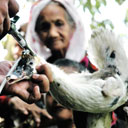
The World Health Organisation confirmed today that it "cannot rule out" the possibility that bird flu had passed between humans after the deaths of seven members of an Indonesian family from the virus.
The health agency said it was "the most significant" development in bird flu, as far as questions of public health and safety were concerned.
Scientists were investigating whether the family members, from Kubu Semelang village in North Sumatra, caught the disease after some of them spent the night in the same room as a relative who was suffering from coughing and other bird flu symptoms on April 29.
The 37-year-old woman died on May 4 and was buried before specimens could be taken but epidemiologists believe she died from bird flu. Since then, six members of her family - her two sons, sister, brother, niece and nephew - have died. Her 25-year-old brother is currently being treated for bird flu symptoms.
""This is the most significant development so far in terms of public health," Peter Cordingley, spokesman for the West Pacific region of the WHO, told Reuters. "We have never had a cluster as large as this. We have not had in the past what we have here, which is no explanation as to how these people became infected. We can't find sick animals in this community and that worries us," he added.
In a statement, the WHO said that all the confirmed cases could be directly linked to "close and prolonged" exposure to the woman during a phase of severe illness.
"Although human-to-human transmission cannot be ruled out, the search for a possible alternative source of exposure is continuing," the agency said.
Investigators were now searching for other people suffering from the disease but to date had found no evidence that bird flu had spread within the general community, nor that efficient human-to-human transmission had occurred, the WHO said.
Bird flu has killed 124 people worldwide, more than a quarter of them in Indonesia, in the latest outbreak which started in 2003. Hundreds of millions of birds have also died and most human cases have been traced to contact with infected poultry.
The disease only spreads to humans in rare cases but epidemiologists fear the virus could mutate into a form easily transmissible between humans, possibly triggering a flu pandemic.
Limited transmissions between people - the result of very close and prolonged contact when the sick person is coughing and probably infectious - is considered by scientists likely to have previously occurred in Hong Kong, Vietnam, Thailand and Indonesia.
Crucially, in the latest cluster of cases, the WHO said that its reference laboratories in Hong Kong and the US had carried out genetic sequencing on all eight gene segments found on specimens from victims and there was "no evidence of genetic reassortment" with human or pig influenza, and no evidence of significant genetic mutations.
That was reassuring to virologists who say that several genetic mutations will be required before any pandemic could break out.
"The comforting factor is that the genetic sequences are not in any way different from what we have seen before. The real worry would be if they had come up with a new mutation or evidence there had been genetic swapping with a human or pig," Professor Hugh Pennington of Aberdeen University told Guardian Unlimited.
"At the end of the day that is what the fear is. Clearly if you have a mutating virus, that is the nightmare scenario. If they have sequenced this and it is the same as seen before it is not a major development. In that sense it is not a fundamental change."
Bird flu has infected people in 10 countries in Asia, the Middle East and Africa since it re-emerged in 2003. Its deadly form, H5N1, swiftly kills poultry but rarely kills people, in part because the viral receptors in humans are in the depths of the lungs, meaning prolonged contact with a substantial quantity of the disease is required. In practice, that has meant people who live or work in close contact with infected poultry.

